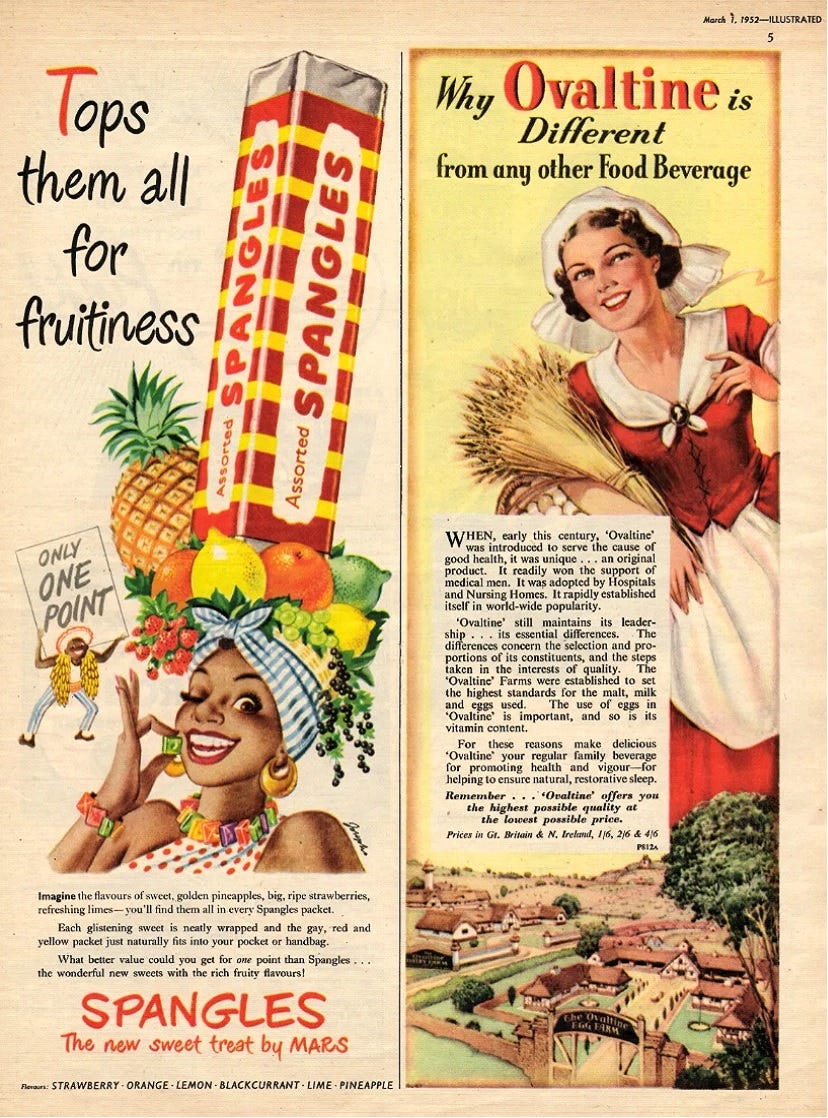The Palm-Wine Drinkard, Amos Tutuola, 1952 - Part 7
On our way to the Unreturnable-Heaven’s town
Welcome back to Seventy years of books, where I'm blogging my way through the seventy titles originally compiled for the Big Jubilee Read. This week, I’m continuing with the first book, Amos Tutuola's The Palm-Wine Drinkard.
Before we move onto the book, I just wanted to share this little sighting of Sooty I had in Blackpool, following his appearance last time.
Sooty was performing on the North Pier in Blackpool as early as 1948, long before his television debut in 1952, and you can still see the original puppet there. And now back to The Palm-Wine Drinkard!
On our way to the Unreturnable-Heaven’s town
The palm-wine drinkard and his wife arrive, unwillingly and inexplicably, in Unreturnable-Heaven’s town, where many things are topsy-turvy, such as the inhabitants climbing a ladder before they position it. This creates a nice sense of disorientation.
The residents of the town are very violent towards the couple. There is an increasing feeling that the palm-wine drinkard and his wife are rapidly losing all control from their forced arrival in the town to the assaults the townspeople rain upon them.
After escaping the dreadful Unreturnable-Heaven’s town, the palm-wine drinkard and his wife consider returning to her father in her hometown, but decide instead to keep moving forward as going back would be too difficult.
This brings up a nice philosophical point around only being able to move forwards and not go back, which amusingly contradicts the palm-wine drinkard’s entire mission to recover his dead palm-wine tapster.
There are again lots of references to time creating a sense of pace and there are also a lot of references to distances travelled which adds a feeling of weariness.
The palm-wine drinkard tenderly cares for his wife while she is recovering from their escape, actually to his own detriment, which reinforces their relationship and adds a feeling of genuine love between the couple.
The control they have lost has not however been regained as once more unknown forces take control of their movements. They are dragged by a white tree into its hollow where they meet Faithful-Mother. I love this image of a magical woman in the trunk of a tree which reminded me of the residents of Enid Blyton’s Faraway Tree series.
This week in 1952
Pete Farndon, founding member and bass guitarist of band, The Pretenders was born on 12 June. Actress, Isabella Rossellini was born on 18 June and actor, John Goodman was born on 20 June.
On 11 June, actress, Agnes Moorehead, known for spectacularly playing Samantha’s mother, Endora on Bewitched and, actor Jack G. Lee were divorced.
1952 song of the week: Blue Tango, Leroy Anderson
This dramatic instrumental has prominent strings and heavy percussion which together create a sense of beckoning, familiar to the themes of a tango. The magical ending finishes the piece on a mysterious note.
Blue Tango was later named the bestselling song of 1952 by Billboard and was covered several times including some versions with lyrics, written by Mitchell Parish.
1952 products of the week: Spangles and Ovaltine
While neither of these products were founded in 1952, I couldn’t resist including them after I found this great advert from a magazine printed in March 1952.
Both adverts, especially the Spangles one, are very much of their time. They take a very different approach, with Spangles being focussed on fun and flavour and Ovaltine on health benefits, but both make a point of being affordable in the post-war world. I particularly like that Spangles are advertising that they are available for only one ration coupon rather than the two required for other sweets. As I said in an earlier post, although tea rationing in the UK ended in 1952, sugar (including sweets) would remain rationed until 1953.
Spangles themselves were launched in 1950 and proved very popular, partly due to this one ration token requirement. They were eventually discontinued in 1984 before being briefly reintroduced in 1995 - I do have memories of receiving Spangles in party bags given out at birthday parties as a child. Tunes lozenges were originally a relative of the Spangles brand and continue to share the shape of the original sweets today.
Ovaltine is much older, originally being introduced in 1904 and continues to be available today. Originally invented as a fortified powdered, hopeful solution to malnutrition, it’s something that I and many others of my generation remember being given by Gran when you were sick. Die hard fans love their Ovaltine whipped up in a latte or even as an unusual topping for ice cream!
As someone who works in marketing, something which particularly struck me about these adverts is how much text is included. Comparing them with an advert from this year, you can see how much less text we tend to use for adverts now.
The adverts from 1952 are more about storytelling and using the story to sell the product, whereas today’s advert is selling an image of “a comfortable, better life” in much fewer words. One of the things I’ve been taught when designing an infographic is that if it takes more than fifty seconds to read, there’s too much text. Print advertising is similar in that it is more visual today, with at a glance slogans to reinforce the images and if further information is needed, it’s added in smaller text, like the company and website information above.
Historical perspectives: The Singing Street: children playing in Edinburgh (1950s)
This great little video from the National Library of Scotland shows children playing in 1950s Edinburgh.
The footage shows skipping and roller skating with a soundtrack of children singing traditional songs.
It’s a lovely, joyous little montage that shows the dying art of children playing.
You can find all of the Seventy Years of Books archive here.









